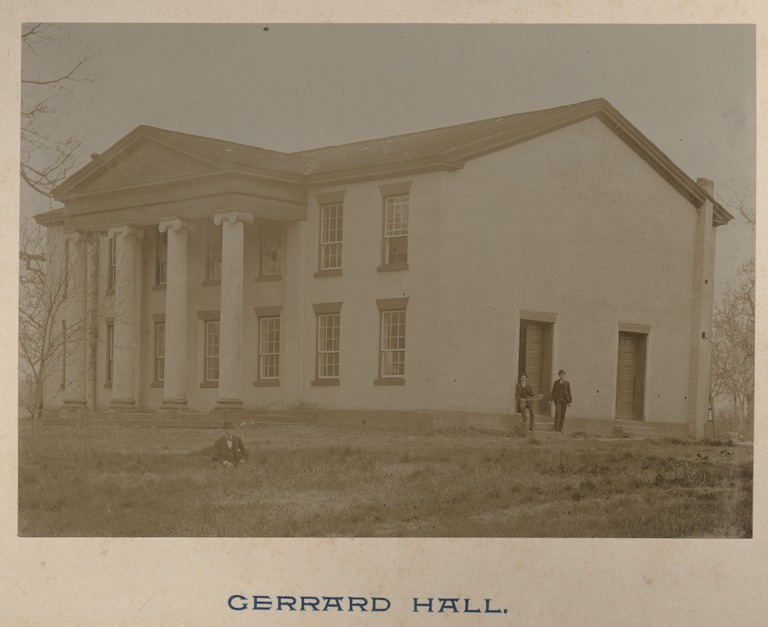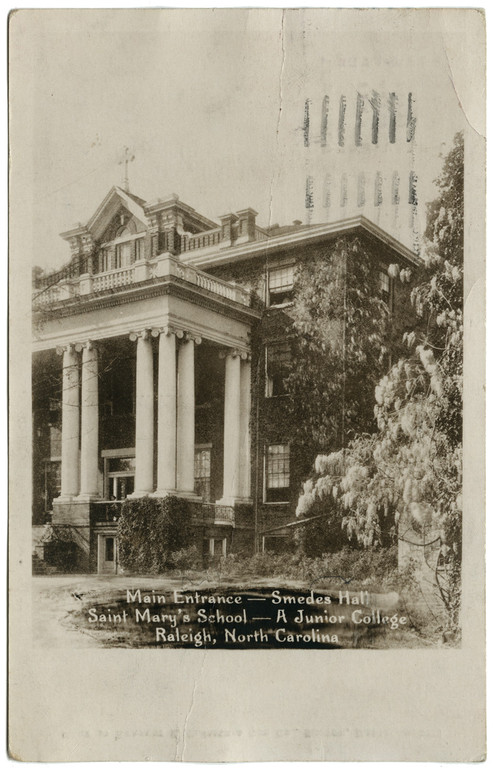Waitt, Thomas A. (ca. 1808-1855)
Variant Name(s):
Thomas A. Waite
Birthplace:
Medford, Massachusetts, USA
Residences:
- Wake County, North Carolina
Trades:
- Builder
- Carpenter/Joiner
NC Work Locations:
Building Types:
Styles & Forms:
Greek Revival
Thomas A. Waitt (Waite) (ca. 1808-1855), was a carpenter and builder from Medford, Massachusetts who was active in Raleigh and at the University of North Carolina in Chapel Hill. When Waitt came to North Carolina is not known. He was probably a kinsman to builder Kendall B. Waitt, also of Medford. Thomas Waitt’s earliest known works included the 3-story brick building that is now Smedes Hall at St. Mary’s School in Raleigh. He and builder William Drummond (formerly superintendent at the State Capitol) undertook the project, which was financed largely by Orange County planter and Raleigh banker Duncan Cameron. Cameron also employed Drummond and Waitt to build his large, frame residence, the Duncan Cameron House, which stood across present Hillsborough Street from the campus. In 1837, while the house was under construction, Drummond left Raleigh, leaving Waitt in charge of the project. Cameron family papers include several bills and receipts from Fayetteville suppliers, addressed to “Mr. Thomas A. Waite, Esq., Architect.”
Probably because of Cameron’s position as a trustee at the University of North Carolina, Thomas A. Waitt became the university’s “Superintendent of Buildings” for a brief period. In January 1836, Waitt was corresponding with professor Elisha Mitchell about possible construction of an observatory on the campus, and that summer he offered a proposal to repair the university’s steward’s hall and outbuildings. Among his duties was completion of Gerrard Hall, a 2-story brick building raised but left unfinished by William Nichols in 1822. Waitt finished the interior, replaced the shingled roof with tin, and built the Ionic portico planned by Nichols. Kemp P. Battle, historian of the university, commented that “the chief carpenter and manager was Thomas Waite, a man of force but careless in his financial dealings; extravagant but not chargeable with dishonesty.”
The university trustees decided to build a monument on campus to honor former President Joseph Caldwell. A sandstone obelisk design proposed by Waitt was selected, after advice from architect David Paton. It was installed, but the sandstone subsequently deteriorated, and in 1858 it was replaced with a marble obelisk. Waitt’s marker was later moved to the Chapel Hill cemetery, where it marked the graves of university slaves. Also in 1837, the university trustees planned to erect a building in honor of Caldwell, to contain a laboratory, lecture room, and library. Battle stated that Waitt was “instructed to take measures for its construction,” but because of his “unbusinesslike” management of the Gerrard project and others, the project was suspended. A bill from Waitt to the university trustees lists various free and enslaved workmen who were working with him in the spring of 1837, including Kendall B. Waitt and numerous other carpenters, bricklayers, and a rock cutter.
In 1840, Thomas Waitt joined Raleigh builder Dabney Cosby in designing and building a large brick residence with full portico, called “Will’s Forest,” for a member of the Mordecai family. The contract indicates that Waitt drew the plans. He was to do the carpentry work, Cosby the masonry work. The specifications, in Waitt’s handwriting, referred to drawings and called for elaborate interior finish, including “eliptic” arches, a “geometric” staircase, and pilasters framing the parlor doors and windows. (George W. Mordecai Papers, Southern Historical Collection.) Cosby and Waitt also built a greenhouse for Duncan Cameron, probably at his Raleigh residence, in the 1840s.
Thomas Waitt married Grizzy Robinson (Robertson) of Wake County in 1836 and in later years lived on a farm in Wake County with her and their children. Records for Medford, Massachusetts list the marriage of Gressy Robinson of North Carolina to Thomas Waitt, son of Darius and Marcy (Mercy) Waitt of that community. He died intestate in 1855.
- Kemp Plummer Battle, History of the University of North Carolina From Its Beginning to the Death of President Swain, 1789-1868 (1907).
- Cameron Family Papers, Southern Historical Collection, Wilson Library, University of North Carolina at Chapel Hill, Chapel Hill, North Carolina.
- Archibald Henderson, The Campus of the First State University (1949).
- George W. Mordecai Papers, Southern Historical Collection, Wilson Library, University of North Carolina at Chapel Hill, Chapel Hill, North Carolina.
- United States Census.
- University Papers, Southern Historical Collection, Wilson Library, University of North Carolina at Chapel Hill, Chapel Hill, North Carolina.
- James Vickers, Chapel Hill: An Illustrated History (1985).
- Wake County Records (Deeds, Estates Papers, Miscellaneous Papers), North Carolina State Archives, Raleigh, North Carolina.
- Elizabeth C. Waugh, North Carolina’s Capital, Raleigh (1967).
Duncan Cameron House
Contributors:Jack Dewey, carpenter; William Drummond, builder; Samuel Hancock, brickmason; Thomas A. Waitt, builderDates:1835
Location:Raleigh, Wake CountyStreet Address:Hillsborough St., Raleigh, NC
Status:No longer standing
Type:Residential
Images Published In:Elizabeth C. Waugh, North Carolina’s Capital, Raleigh (1967).
Note:The house built in 1835 for Duncan Cameron was remodeled in 1901 for his grandson Bennehan Cameron, who added a large portico and additional rooms. It stood on the south side of Hillsborough Street opposite St. Mary’s School. Portions of its interior woodwork are said to have been reused in a house in Raleigh’s Hayes Barton neighborhood.
Gerrard Hall
Contributors:Atwood and Nash, architects and engineers (1938); Thomas C. Atwood, engineer (1938); Arthur C. Nash, consulting architect (1938); William Nichols, architect (1822-1837); Thomas A. Waitt, builder (1837); H. Raymond Weeks, architect (1938)Variant Name(s):New Chapel
Dates:1822-1837; 1858 [improvements]; 1938 [internally reconstructed]
Location:Chapel Hill, Orange CountyStreet Address:University of North Carolina, Chapel Hill, NC
Status:Standing
Type:Educational
Images Published In:John V. Allcott, The Campus at Chapel Hill: Two Hundred Years of Architecture (1986).
M. Ruth Little, The Town and Gown Architecture of Chapel Hill, North Carolina, 1795-1975 (2006).
C. Ford Peatross, William Nichols, Architect (1979).
William S. Powell, The First State University: A Pictorial History of the University of North Carolina (1992).Note:As built from Nichols’s design, Gerrard Hall included an imposing Ionic portico on one side; the portico was removed ca. 1900, and recreated in 2007-2008. The hall was rebuilt internally in the 1930s.
Joseph Caldwell Monument
Contributors:Thomas A. Waitt, architectDates:1837
Location:Chapel Hill, Orange CountyStreet Address:Chapel Hill Cemetery, Chapel Hill, NC
Status:Standing
Type:Memorial
Smedes Hall
Contributors:William Drummond, builder (1835-1837); Samuel Hancock, brickmaker (1835-1837); Charles E. Hartge, architect (1909); Thomas A. Waitt, builder (1835-1837)Variant Name(s):Main Building
Dates:1835-1837; 1909 [addition]
Location:Raleigh, Wake CountyStreet Address:Hillsborough St. at St. Mary’s St., St. Mary’s School, Raleigh, NC
Status:Standing
Type:Educational
Images Published In:Linda L. Harris and Mary Ann Lee, An Architectural and Historical Inventory of Raleigh, North Carolina (1978).
Elizabeth C. Waugh, North Carolina’s Capital, Raleigh (1967).Note:The illustration shows Smedes Hall as remodeled by Charles E. Hartge.
Will's Forest
Contributors:Dabney Cosby, builder; Thomas A. Waitt, architectVariant Name(s):Ann Willis Mordecai House
Dates:1840-1842
Location:Raleigh, Wake CountyStreet Address:Devereux St., Raleigh, NC
Status:No longer standing
Type:Residential
Images Published In:Elizabeth C. Waugh, North Carolina’s Capital, Raleigh (1967).
Wills Forest Plantation House
Contributors:Albert and Osborne, brickmasons and plasterers; Dabney Cosby, brick contractor; Thomas A. Waitt, architect and builderVariant Name(s):Devereux House
Dates:1840-1841
Location:Raleigh, Wake CountyStreet Address:Wills Forest St., Raleigh, NC
Status:No longer standing
Type:Residential
Images Published In:Elizabeth C. Waugh, North Carolina’s Capital, Raleigh (1967).
Note:A rare example of a temple-form residence constructed in brick and featuring an Ionic columned portico, it was razed about 1900. Also known as the Devereux House.


